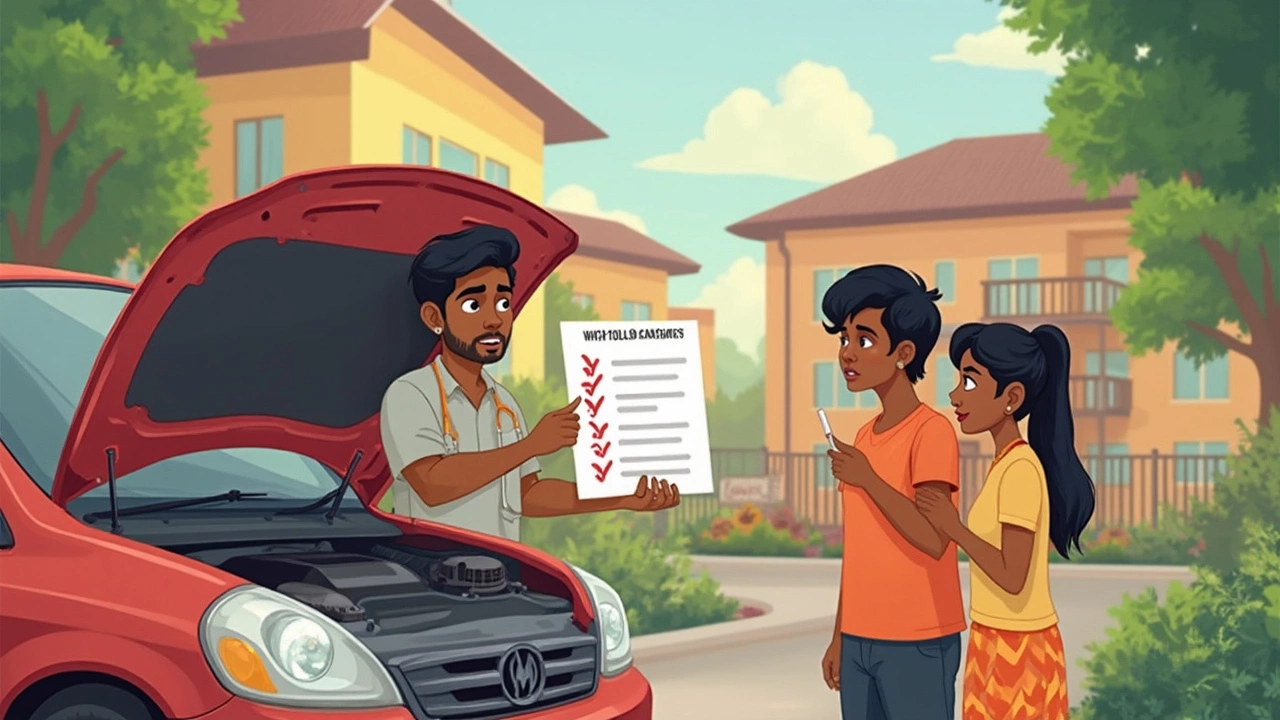That odd clunk every time you hit a bump? Not normal. Your car’s suspension is supposed to keep rides smooth, but once something breaks or wears out, your ears are usually the first to know. Drivers miss early clues just because they haven’t heard what a busted suspension actually sounds like.
If you’re hearing knocking, creaking, squeaking, or rattling below you—especially when going over potholes or making turns—you might have a suspension problem. These aren’t just random sounds. Each noise usually points to a specific part that's having a tough time, from worn shocks to loose control arms.
Ignoring that sound isn’t just annoying; it’s expensive later. A weird rattle today can turn into major steering or tire trouble down the road. Knowing the exact noise your car makes is the easiest way to keep things running safely and avoid a monster repair bill.
- The Usual Suspects: Common Noises from Bad Suspension
- What Each Noise Really Means
- Where the Sounds Come From
- How to Check for Suspension Issues Yourself
- When to Get Help (and What Happens If You Wait)
The Usual Suspects: Common Noises from Bad Suspension
It’s pretty wild how your car actually “talks” to you when something’s wrong with the damaged suspension. Every noise has a story. Here’s what you’ll usually hear if there’s trouble with your suspension parts:
- Clunking: This one stands out the most. You’ll hear it when you go over bumps or hit potholes. It usually means a ball joint, sway bar link, or strut mount is loose or worn out.
- Squeaking: That high-pitched squeak, especially when the car bounces or you steer, typically comes from dry bushings or worn out control arm bushings. Sometimes it’s a sign your shocks need attention.
- Rattling: If it sounds like there are marbles rolling around under your car, that’s probably a loose part—maybe a worn sway bar or a broken spring clamp.
- Groaning or creaking: You’ll notice this noise when you steer at slow speeds or the suspension flexes. Dry ball joints or control arm bushings are the usual suspects.
- Knocking: A repetitive knock while driving over uneven roads? That points to a loose or broken strut or shock absorber.
| Noise Type | Likely Cause |
|---|---|
| Clunking | Loose ball joint, sway bar, or strut mount |
| Squeaking | Worn bushings, bad shocks |
| Rattling | Loose part, broken spring clamp |
| Groaning/Creaking | Dry ball joints or bushings |
| Knocking | Faulty strut or shock absorber |
Nobody’s born knowing what a busted suspension sounds like. If your car’s suddenly got a wild new soundtrack, these are the noises to listen for. Spotting them early helps cut down on repair bills—and keeps you safer on the road.
What Each Noise Really Means
Each weird sound from your suspension is basically a warning sign. Figuring out what type of noise you’re hearing can actually tell you which part needs some love. Let’s break it down so you’re not left guessing every time your car talks back.
- Clunking: This is the loud, sometimes dull bang you hear when going over bumps. It usually means a ball joint, control arm bushing, or sway bar link is loose or shot. Translation: something’s moving around that shouldn’t be.
- Squeaking or Creaking: High-pitched squeaks especially when turning can point to dry bushings or worn-out car suspension parts. Creaking at low speeds is a common cry for help from old shock mounts or rubber bushings.
- Rattling: Hear a rapid rattle or shake, kind of like marbles in a can, especially at slow speeds or on rough roads? That often means loose nuts, bolts, or brackets on your suspension. Sometimes it’s a failing strut mount bouncing around in its housing.
- Groaning or Grinding: A groan you feel in the steering wheel often ties to upper strut mounts or metal bushings with no lubrication left. Sometimes a bent control arm can also grind on nearby suspension parts.
- Knocking: Similar to clunking, but usually more rhythmic and can mean bad tie rod ends, a worn shock absorber, or issues with the coil springs.
Want a quick cheat sheet? Here’s what the noises usually mean for the main suspension problems:
| Noise | Likely Cause | Typical Fix |
|---|---|---|
| Clunking | Loose ball joint/control arm | Replace joint or bushing |
| Squeaking | Dry/worn bushings | Lubricate or replace bushings |
| Rattling | Loose strut mount or nut/bolt | Tighten or replace mount/hardware |
| Grinding | Metal-on-metal from bushings or control arms | Replace worn components |
| Knocking | Shock, tie rod, or coil spring issue | Inspect and replace faulty part |
Catching these suspension noise clues quickly can save you major money. That five-minute noise check in your driveway can mean the difference between swapping out a $30 bushing now or dealing with a full suspension replacement later on. So next time your car makes a weird sound, don’t just turn up the radio—a little detective work goes a long way.

Where the Sounds Come From
Ever wonder what’s actually making all that noise under your car? The main troublemakers in the damaged suspension club are ball joints, bushings, control arms, strut mounts, and shocks or struts. Each of these parts helps keep your wheels in place and your ride smooth, so when they start to go bad, it’s almost like a band playing off-key below your feet.
Ball joints are like the pivot points that let your wheels turn. When they dry out or get loose, you’ll get a metallic clunk every time you hit a bump or turn sharply. Bushings—those small rubber pads—sit between metal parts to prevent metal-on-metal contact. Once those bushings wear down, the rubber can’t soak up vibrations, so you’ll hear squeaks and rattles, especially if you’re driving on rough roads. Control arms connect the wheels to the car, so if their ball joints or bushings go bad, expect knocking noises from down low when going over bumps.
Strut mounts hold your car’s struts in place. If they break down, you get extra noise and even steering problems. Shocks or struts themselves can make a hollow knocking or even a thud sound if they’re leaking hydraulic fluid or their internals are busted. These noises usually mean your car isn’t absorbing bumps well, so you’ll feel and hear every pothole more than you should.
- Knocking sound? That’s often the control arm or ball joint letting you know they’re tired.
- Creaking or squeaking? Probably worn bushings or dry ball joints.
- Rattling at low speed? Check the sway bar links and bushings.
Mechanics report that about 60% of noise complaints linked to the suspension noise category are caused by worn bushings or control arms. If you want to spot the exact spot the noise is coming from, ask a buddy to bounce each corner of the car while you kneel next to the wheel wells—sometimes you’ll hear the telltale groan or knock right away.
Identifying where the sound comes from isn’t just about fixing the annoyance. Pinpointing it can help you avoid further damage—letting a minor suspension problem drag on can eventually mess with your steering, braking, or even tire wear.
How to Check for Suspension Issues Yourself
You don’t need a full garage or a mechanic’s degree to spot suspension problems. Most checks can be done in your driveway. Listening is great, but combining sound with some quick hands-on inspections helps catch issues early. Here’s what you can do before calling in the pros.
- Do the bounce test. Push down hard on each corner of the car. When you let go, it should spring back up once, maybe twice, and then settle. If it keeps bouncing, your damaged suspension (usually the shocks or struts) isn’t doing its job.
- Look at tire wear. Uneven tire wear, or cuts and bald patches near the edges, often means your suspension isn’t keeping the wheels aligned or planted.
- Listen up during a slow drive. Drive slowly over speed bumps or take sharp corners in a quiet parking lot with the windows down. Notice clunks, squeaks, or rattles? Try to pinpoint if it’s coming from the front or the back.
- Check under the car. Look for signs of leaking fluid around the bottom of shock absorbers or struts. If they’re oily, it’s a red flag.
- Inspect bushings and mounts. With the car safely parked, get down low and look at rubber bushings, ball joints, and mounts. Torn, cracked, or missing rubber parts can let metal parts bang together, causing those annoying suspension noise problems.
If you’ve got a jack and jack stands, you can try gently moving the wheels side-to-side and up-and-down (with the car in park and the wheels off the ground). A lot of play usually means worn-out parts like tie rods or ball joints.
| Check | What’s Normal | What’s a Problem |
|---|---|---|
| Bounce Test | Quick rebound, settles fast | Keeps bouncing |
| Tire Wear | Even pattern across tread | Edges worn, random bald spots |
| Shock/Strut Check | Dry, clean body | Leaking oil, dirt buildup |
| Noise When Driving | Silent, smooth ride | Knocking, squeaks, rattles |
Catching a damaged suspension early saves headaches (and money) later. If you spot any of these issues or feel something’s off, that’s the time to chat with a mechanic for a real fix before things get worse. Your car – and your wallet – will thank you.

When to Get Help (and What Happens If You Wait)
There’s a fine line between a harmless squeak and a busted damaged suspension that’s out to wreck your day. If those clunks, bangs, or rumbles stick around for more than a few short drives, don’t assume they’ll just vanish. When your car starts making unfamiliar noises—especially deep knocking, clanking, or crunching—those are all red flags that you should reach out to a pro quicker rather than later.
Here’s a tip: if your car starts swaying too much on turns, feels extra bouncy over bumps, or your steering wheel shakes more than usual, those are classic signs the suspension is hurting. If you ignore these sounds, bigger problems sneak up fast. We’re talking uneven tire wear, steering issues, and even failing state inspections because the car can’t keep itself stable.
“Driving with warning noises from your suspension can lead to unexpected breakdowns and safety issues. It’s always safer and cheaper to address problems early,” says John Ibbotson, chief mechanic at Consumer Reports.
Kicking the can down the road doesn’t just risk more expensive repairs; it can turn your vehicle into a safety hazard. Shock absorbers, control arm bushings, and ball joints especially—if they give out, you could totally lose control on a rough road or at highway speed. According to AAA research, suspension failures are responsible for a surprising number of roadside breakdowns every year.
| Issue | Potential Result | Estimated Cost if Ignored ($) |
|---|---|---|
| Worn shocks | Uneven tire wear, less stopping power | 200–600 extra |
| Broken control arm | Loss of control, tire damage | 600–1,000+ |
| Ignored ball joint noise | Wheel detachment | 1,500+ (plus tow) |
Bottom line: if your car’s making weird sounds every time you go over a bump or take a sharp turn, don’t risk it. Bring it in for a check. Sometimes it’s minor, like a loose nut. Don’t wait for something small to snowball into a wallet-busting repair or a risky situation on the road.




